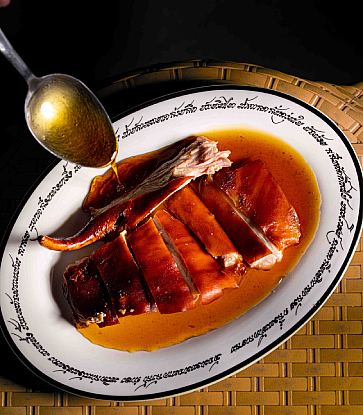When asked what the signature Isan dish is, most people will answer, without missing a beat, som tam with piping-hot grilled chicken and sticky rice. But there is another dish that is just as iconic Isan, as it also embodies the cultural heart and soul of the region. That signature dish is lab or larb.
A delicious dish that is woven into Southeast Asian cultures
Larb is actually a common dish that can be found across Southeast Asia. Along with the Thai/Isan version, larb dishes are served in Northern Thailand, Myanmar’s Shan State, Laos, and Xishuangbanna in China’s Yunnan Province. No matter where you find them, all these larb dishes begin as minced meats mixed with various seasonings, but it is each region’s local tastes and flavours that make their larb unique.
The delicious secrets of Isan culture
In the past, larb was a dish for guests, served at important festivals and special occasions, such as merit-making rites, weddings, and funerals, when pigs, cows, or buffalos would be slaughtered as part of the ceremonies. Traditionally, hosts would offer larb to honour and thank guests for participating in the festivities. As meat was not a common part of meals back then, this generosity and hospitality are still an integral part of the local culture. Today, meat is more widely available, so people can eat larb more often. It is a regular item on most menus of Isan restaurants, with many listing it as their signature dish. They will even specify their recipes’ origins, such as larb Yaso, larb Khon Kaen, or larb Udon, to show off the unique flavours of their larb.
Spiciness of larb Isan
larb Isan is known for its robust spiciness. Minced meat is usually seasoned with lime juice, fish sauce, chilli powder, grounded roasted rice, shallots, and spring onions. Some recipes also include coriander and mint leaves. To add additional flavour and textures, it is served with local produce, such as cabbage, cucumbers, long beans, acacia shoots, basil, bael shoots, neem leaves, fried chillies, and more.Generally, people in the Northeast prefer beef larb, but the meat choices are endless. Chicken, duck, buffalo, fish, pork, or other fowl are options, as are various types of venison like antelope or barking deer. Some people may include skin and offal, including livers and gizzards, as it gives the larb additional textures and flavours. There is even a version called “larb khom” (bitter larb), which includes digestive juices or bile.
Nevertheless, every region, even every restaurant, in the Northeast may have its own particular recipe. Some may feature sour notes, while others are spicier and even others are on the bitter side. But they all have basically the same basic ingredients that epitomise the enchanting flavours in every bite of larb across Isan.

What makes larb so tasty?
Nattaphong Saehu, owner of Phed Phed Bistro, a popular Isan restaurant in Bangkok, and Phatcharee Nimmongkhon of So Jeng restaurant in Khon Kaen are both Bib Gourmand awardees in MICHELIN Guide Thailand 2023 and offered their takes on larb tastiness.“Back in the day, larb Isan emphasised the freshness of the meat, like beef, pork, ducks, and chicken. Even fish, we would eat on the day it was caught. Even the herbs have to be fresh. This is different from the larb made in the North, which is more about seasonings. Also, the herbs must be suitable for the meat as well. For example, duck larb has chopped bergamot leaves and fried shallots and garlic as a garnish, as well as fried bergamot leaves as an accompaniment. With fish larb, we would add sliced lemongrass, galangal, and Vietnamese coriander, which would take care of any fishy smell from the freshwater fish typically caught in Isan. Beef larb tends to have spicy heat followed by salty and sour flavours. Bitter larb gets its signature taste from the animal’s digestive juices. Back to the fish version, that distinctive tartness adds a brightness to the dish’s texture,” explained Saehu.

Nimmongkhon is a Khon Kaen native and has been running So Jeng restaurant, which specialises in beef offerings, in her hometown for over 30 years. She believes that in addition to fresh meats and herbs, each restaurant’s recipes are at the foundation of their delicious dishes.
“So, at our restaurant, we roast and grind our rice with bergamot leaves, which adds a wonderful aroma to our larb. And our chilli powder is pure. There are no pieces of rice bran or chilli stems or seeds. If you do not make your own chilli powder, that is what you might find in the store-bought kind. It does not add any flavour, only colour and bulk. Aside from that, the type of meat will also add to the deliciousness of the larb. At So Jeng, we only use beef that does not have sinews or tendons, which is usually the rump or round. It is tender and not chewy, so it is easy to eat.” This youthful restaurant owner also added how diners’ preferences are also important.
“Actually, I think that every restaurant has its own flavour profile. It might be sharp and robust or balanced and subtle. Originally, we focused on serving larb with three flavours – spicy, salty, and a little sour. But palates change over time. Today, people prefer more spicy foods. So, we pay attention to the customers themselves as well. If the diners are older adults, children, or foreigners, we may ask them if they want our version, or would they prefer their food to be less spicy or less salty. Others tell us they prefer very hot seasoning. This is because food, especially larb, is about personal tastes. We want our customers to enjoy the flavours they like. But if you want our traditional recipe, then we will make it the way we usually do.”

What goes best with larb?
Both restaurateurs agree that a must-have with larb is sticky rice. Also, there should be fresh vegetables. In Isan, people like seasonal vegetables that are astringent and pungent, such as wild guava leaves, bok choy, striped eggplant, heart leaf, wild betel leaves, mint, neem, and scythe tree leaves. Their robust flavours complement the larb and help neutralise any odours.Speaking about food that brings flavours together, the owner of Phed Phed Bistro explained that it is usually a soup. People from Isan are known for their cuisine that uses every part of an animal. So, larb beef is often served with beef soup with offal for a slight bitterness. If it is fish, then the head and bones would go into a soup to go with the larb fish and sticky rice. Sipping the soup helps soothe the throat and boost the appetite. To go with larb beef, So Jeng’s owner recommended many other dishes, including koi khom (similar to tartare), tom sap neua puaei (piquant soup with braised beef), mam (Isan sausage made with meat and offal), and kaeng om (a type of thick Isan stew eaten with glutinous rice), among other Isan specialities.
Taking a trip to tour the delicious flavours of Isan
If you are planning a trip to the Northeast, make sure to check out the latest edition of MICHELIN Guide, which has been expanded to include that region’s restaurants in such cities as Nakhon Ratchasima, Ubon Ratchathani, Udon Thani, and Khon Kaen. Along with enjoying the savoury delights of authentic larb and other local delicacies, you can also visit the many beautiful and interesting attractions. It is definitely worthwhile to visit the area and taste some delicious Isan food.
Visiting Nakhon Ratchasima
If you are going to Nakhon Ratchasima, Lab Somphit (Bib Gourmand, MICHELIN Guide Thailand 2023) has been serving Isan specialities for over 50 years, including larb koi and nam tok (spicy sliced meat salad), including a version named after the owner, Somphit, who prepares the ingredients every day. Each dish is prepared with care so you can taste the freshness. You can also stop by Khao Yai National Park for the relaxing fresh air or visit Phimai Historical Park to soak in some historic culture.
Visiting Khon Kaen
A trip to Khon Kaen should include a stop at So Jeng (Bib Gourmand, MICHELIN Guide Thailand 2023), which has been a popular eatery in the Ban Phai district for over 30 years. It is known for its larb, koi khua, saleud nuea lai, krabak tod (fried pork cakes), mok samong mu (steamed pork brains), and kaeng om nuea (clear curry with beef). You can then continue to feed on the delightful views at Hin Chang Si View Point and Phu Pha Man National Park.
Visiting Udon Thani
During your travels to Udon Thani, you should not miss a meal at Krua Khun Nid (Bib Gourmand, MICHELIN Guide Thailand 2023), a local favourite for over 40 years. Known for its fresh ingredients, its menu highlights seasonal as well as classic Isan dishes, including fried pickled fish and larb fish made of knifefish and wrapped in fragrant grilled banana leaves. If you love these flavours, you buy ingredients such as chilli pastes so you can prepare these dishes at home. You can also visit such well-known attractions as Red Lotus Lake and Na Yung-Nam Som National Park, which covers three provinces – Udon Thani, Loei, and Nong Khai.
Visiting Ubon Ratchathani
In Ubon Ratchathani, there is View Mun (Bib Gourmand, MICHELIN Guide Thailand 2023), where you can enjoy beautiful views of the Mun River and the tranquil fishing way of life along the waters. The menu here features delicious river fish dishes with catches fresh from the Mun, including larb. Along with savouring Isan food in Ubon Ratchathani, you will also find awesome photo ops at the ethereal Sam Phan Bok sandstone formations.Northeastern Thailand is teeming with beautiful and enchanting destinations, where you can find delicious Isan food in almost every corner. However, even though the coronavirus situation has improved, there is still a risk of this endemic disease in Thailand. So, during your travels, don’t forget to wear a mask, wash your hands, and protect your health. Also, be on the lookout for the SHA logo. SHA (Amazing Thailand Safety & Health Administration) is a project involving the Tourism Authority of Thailand (TAT), Ministry of Tourism and Sports, Ministry of Public Health, and others. SHA certification verifies the safety, hygiene, and sanitation quality of the products and services of Thai businesses in order to ensure a safe travel experience for all travellers.
For more information about this wonderful project, please visit web.thailandsha.com. Or get updates and more information about various attractions for your trip from your travel friends at the TAT Call Centre on 1672 or on Facebook at the TAT Contact Centre.













%20-%20Aman%20Nai%20Lert.jpg)
.jpg)





